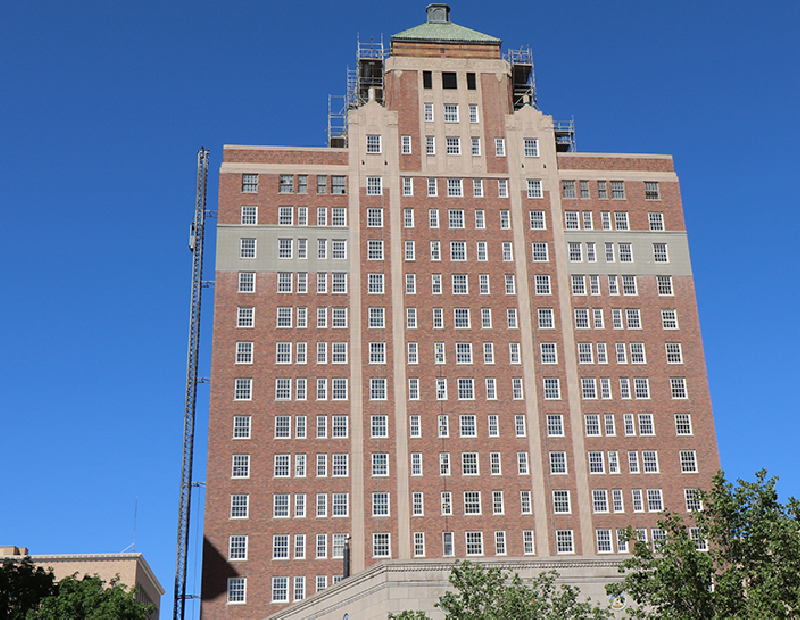What’s Next for C-PACE Financing?
An in-depth update on the dealmaking climate and policy initiatives for the popular energy efficiency financing program.

Marriott Syracuse Downtown. Image courtesy of Petros PACE Finance
As 2020 began, the year was shaping up to be the strongest yet for the use of Commercial Property Assessed Clean Energy (C-PACE) financing. C-PACE had its best year ever in 2019, with approximately $677 million in C-PACE investments—bringing the total over the past decade to more than $1.5 billion, according to PACENation a nonprofit association that advocates for PACE financing.
C-PACE was on its way to another record-breaking year before the novel coronavirus hit the U.S., said Cliff Kellogg, executive director of C-PACE Alliance, a network of C-PACE industry stakeholders. C-PACE financing had risen from just six deals valued at about $3.4 million in 2009 to last year’s record-breaking total—a sharp increase from 2018, when there were 460 deals with C-PACE financing of about $270.2 million, according to PACENation.
Commenting on the pandemic’s potential impact on C-PACE, Kellogg said, “It’s too difficult to predict how the volume will compare to last year. It could be over in two weeks. It could be over in six to eight months.”
READ ALSO: The Power of Green Financing
C-PACE allows commercial property owners to get low-cost, long-term financing for energy efficiency, water conservation and renewable energy projects that is then repaid as an assessment on the property tax bill for current and future owners. Currently, 37 states and Washington, D.C., have enacted authorizing legislation; the program is active in 20 states and Washington.
Two of the largest lenders in the space, Petros PACE Finance and Greenworks Lending, agree that it’s too soon to determine how much the COVID-19 outbreak will affect their businesses and the C-PACE market. “For sure we’ve seen some slowdown,” said Jessica Bailey, CEO & co-founder of Greenworks Lending in Darien, Conn. “We closed all our offices down. We suspended all travel for a couple of weeks.” But, Bailey added, Greenworks has “plenty of deals in the works. I don’t think those will go away.”
Greenworks, which Bailey co-founded with COO Alexandra Cooley in 2015, closes dozens of deals a month, usually ranging from just under $2 million to more than $10 million. Using the example of a $750,000 loan for an office property owner to swap out an aging boiler, Bailey concluded that “those are the deals that happen no matter what’s going on in the economy.”
Mansoor Ghori, co-founder & CEO of Petros PACE Finance in Austin, Texas, said his firm has at least four deals closing in the next few weeks. He expects there may be some pause in the market as the situation continues to evolve but also notes there could also be “opportunity for the PACE side of the business.” He said banks may pull back a little bit on lending and create more space in the capital stack for C-PACE to fill in some of the gaps.
Kellogg noted he still expects volume of C-PACE financing to continue upward because it’s a capital markets solution to a policy priority of converting to a more energy-efficient and less carbon-intensive economy.
“C-PACE financing will increase because it solves an economic puzzle for businesses that own their properties and for commercial property investors,” Kellogg said, adding that C-PACE financing is less expensive than mezzanine debt and addresses the requirements by local governments that are raising the bar for commercial properties in terms of energy efficiency with more stringent building codes and performance standards.
States, Cities Take Steps
There will also be more C-PACE investments because more states are approving enabling legislation and more counties and municipalities are creating program administrators or hiring third parties to run the programs, Kellogg said.
Late last year, new programs were authorized or took effect in New York, Illinois, Pennsylvania, Oklahoma, Virginia and Massachusetts, while Washington has a bill pending on Gov. Jay Inslee’s desk. Other places to watch for this year include:
- New Jersey: the state Senate passed a bill in June 2019
- Illinois: The city of Peoria, along with Will, Lake and McHenry counties, are expected to take steps
- Pennsylvania: Pittsburgh and Allegheny County considering adoption
- Texas: San Antonio’s city council authorized C-PACE, seven years after the state approved the creation of local programs
Kellogg said C-PACE is monitoring new legislation or technical amendments in 10 other states this year. Part of the reason some states have not activated their programs is due to technicalities that needed to be worked out. “Some states enacted enabling legislation that includes non-traditional terms that are unworkable or unappealing to private investment,” he said. Examples include a term extinguishing the lien in the event of a foreclosure or term subordinating C-PACE assessments to other mortgage holders’ secured interest.
Bailey and Ghori noted that their firms and other C-PACE lenders are expecting the New York City market to open up later this year. In April 2019, the New York City Council passed the Climate Mobilization Act, Local Law 97, requiring large buildings, including condominiums and cooperatives, to cut greenhouse gas emissions by 40 percent by 2030 and 80 percent by 2050. C-PACE-enabling legislation was included in Local Law 96. Kellogg said that the New York City Energy Efficiency Corp. is expected to issue implementing rules for comment shortly. According to Bailey, those changes in New York City could enable the multifamily sector “to become a much more interesting market for us.”
C-PACE Deals
Petros funded its first C-PACE project in New York state earlier this year when it closed a $9.9 million transaction with Brine Wells Development, an owner and developer of hospitality properties, to finance energy-saving upgrades as part of the restoration of the historic 261-key Marriott Syracuse Downtown hotel. Fifty rooms and event space have been added to the 1920s-era building along with upgrades to the HVAC, plumbing, lighting and electrical systems.
While hotels are the most popular asset class receiving C-PACE financing, Ghori said other Petros deals have included funding the conversion of an old Ohio warehouse into a self-storage facility, industrial properties in Michigan, office properties in Minnesota and Texas and retail for several large REITs, among other projects. Last spring, Petros closed a $1.7 million transaction in Lincoln, Neb., to incorporate energy-saving measures in the construction of a 92,000-square-foot indoor sports facility.

Wheatfield Gardens. Image courtesy of Greenworks Lending
Among the more unusual projects for Greenworks Lending was a $2 million C-PACE financing that closed late last year for Wheatfield Gardens, a hybrid greenhouse vertical farm in Niagara County, N.Y. The project consists of a combined heat and power system that would be the base of a microgrid facilitating the production of hydroponic lettuce and hemp. It was the state’s first C-PACE project to exceed the $1 million mark.
The firm’s biggest deal to date was a $10 million C-PACE financing to renovate The Plaza Hotel, a historic Art Deco-styled 19-story hotel in downtown El Paso, Texas, into a modern facility with 131 guest rooms, restaurant, bar and event space.
Hotels Check In
Hospitality deals topped the list of building types receiving C-PACE funding over the past 10 years, coming in at approximately $297 million and accounting for 29 percent of the 2,358 transactions through 2019, according to PACENation. Office followed at about $134 million (13 percent); healthcare at $124 million (12 percent); retail at $97.2 million (9 percent); multifamily at approximately $93 million (9 percent); mixed-use at $89 million (9 percent); and industrial at $86 million (8 percent). There is an “other” category with $49 million in financing, or 5 percent, followed by agriculture, religious, recreation, services, education, nonprofit, agricultural and government, all representing about 1 percent each or less of the total percentage of C-PACE funding, on the PACENation list.

The Plaza Hotel in El Paso, Texas. Image courtesy of Greenworks Lending
Ghori explained that hospitality sector owners and developers were the first to pick up on the use of C-PACE funding. “Typically, the hotel capital structure has lots of different kinds of incentives. They are used to looking at different forms of financing and this was something that really fit into what they were trying to do.”
California has had the most C-PACE financing activity at $486 million, according to PACENation. Ohio follows at about $224.5 million. Rounding out the top 10:
- Connecticut, $141 million
- Minnesota, $123.2 million
- Texas, $101.2 million
- Missouri, $82.7 million
- Colorado, $63.4 million
- Wisconsin, $55.4 million
- Utah, $54.8 million
- Washington, D.C., $41 million.







You must be logged in to post a comment.